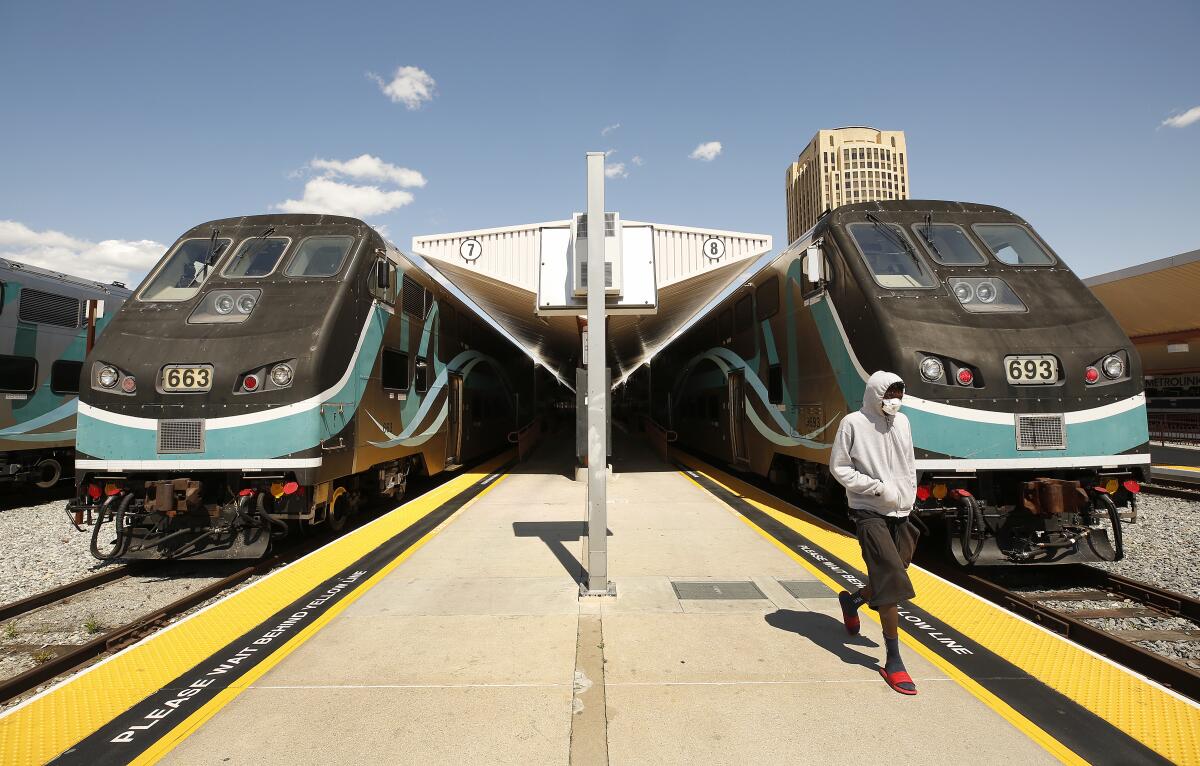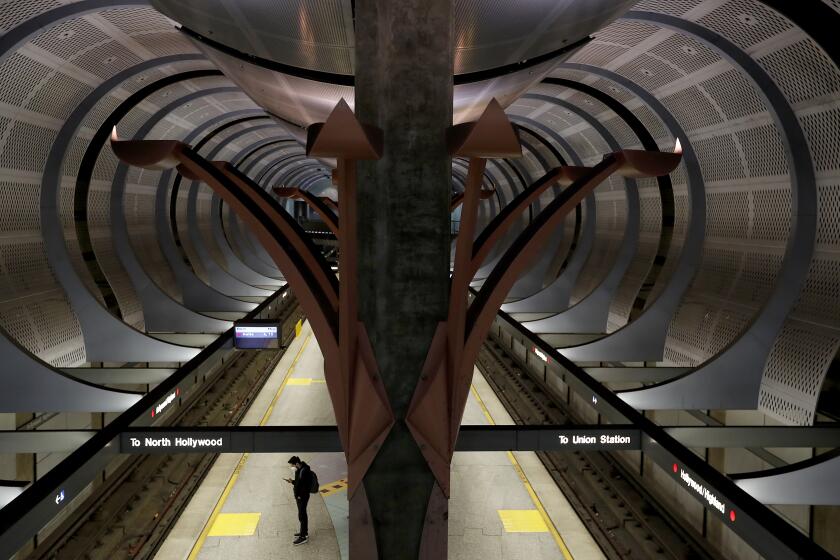Metrolink cuts service by 30% as ridership plummets amid coronavirus outbreak

- Share via
As rail ridership plunges amid the ongoing coronavirus outbreak, Metrolink has significantly scaled back its train schedule, reducing service by 30%, officials said.
The new schedule, effective Thursday and until further notice, maintains peak-time routes and as many connections as possible for riders, said Stephanie Wiggins, chief executive of the regional commuter rail network.
As of last Friday, Wiggins wrote in a public message, ridership was down roughly 80% across the system — which includes routes connecting Los Angeles, Orange, Riverside, San Bernardino, San Diego and Ventura counties.
This week, the drop-off had plunged to 85%, Metrolink spokesman Paul Gonzales said, with daily boardings falling from an average of 43,000 to 6,292.

The decrease can largely be attributed to the spread of the coronavirus, which has prompted local and state leaders to order most Californians to stay at home and to maintain at least a six-foot buffer zone around themselves when they do go outside — something that can be hard, if not impossible, to do on a crowded train or bus.
“This lack of demand means a temporary reduction of our service levels can occur without the danger of creating crowding situations on our trains,” Wiggins said.
Although no routes are being entirely eliminated, Metrolink will operate only 115 trains on weekdays compared with its normal 167. Weekend service will not be affected, Gonzales said.
Metrolink also is making hand sanitizer available on its trains and is cleaning the cars more frequently, he said.
“We take seriously our role as a lifeline transportation service for our community,” Wiggins said. “We also take seriously the need to keep both our riders and employees safe during this global pandemic. So we will continue to do all we can to maintain the cleanliness and social distancing that’s required to minimize the spread of this virus while still providing a vital service.”
Metrolink isn’t alone in its struggles. Statewide, transit agencies have been walloped by tanking ridership during the COVID-19 pandemic.
The L.A. County Metropolitan Transportation Authority reported last week that trips on its six light rail lines were down nearly two-thirds compared with a typical day, and bus ridership was down by about 53%.
In response, the agency is reducing bus service 15% to 20% and running trains less frequently.
Metro ridership has fallen by more than half during the coronavirus outbreak as life in Los Angeles County has all but ground to a halt.
On Tuesday, the Bay Area Rapid Transit system’s ridership was down 92% compared with a typical Tuesday last month, according to the agency. BART service, which normally ends at midnight, now shuts down at 9 p.m.
In addition, San Francisco’s Muni Metro light rail system will be replaced by buses starting Monday. Service already has been suspended on the city’s famed cable car and historic streetcar system.

The Santa Clara Valley Transportation Authority suspended its light rail service Wednesday night after an operator trainee tested positive for the coronavirus, the agency said. Ridership on the system has dropped by 82% since stay-at-home orders were issued, and the agency will now focus on bus service, “which is more nimble and can adapt to the various needs of our community,” it said.
The latest updates from our reporters in California and around the world
Some officials have said they hope the federal government’s roughly $2-trillion coronavirus economic relief package — which the Senate approved Wednesday — will provide a much-needed lifeline, as it includes $25 billion for transit providers.
“There is more work to do, and this is only one step toward keeping the trains running, but it is a significant down payment for the essential workers in the region and commuters when they return,” BART General Manager Bob Powers said in a statement.
It’s not yet clear how much of the transit assistance would flow to California, however.
MTA staff estimated that the agency may get from $710 million to $810 million, spokesman Rick Jager said, “with specific terms on how these funds can be spent on matters directly related to the COVID-19 pandemic.”
More to Read
Sign up for Essential California
The most important California stories and recommendations in your inbox every morning.
You may occasionally receive promotional content from the Los Angeles Times.

















